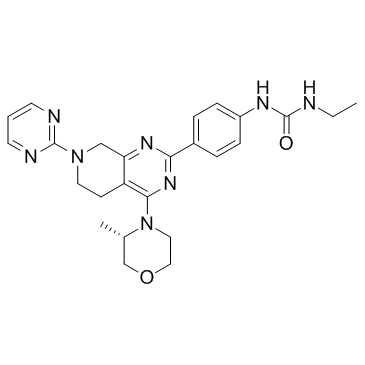mTOR-IN-1
Modify Date: 2025-08-25 17:20:44

mTOR-IN-1 structure
|
Common Name | mTOR-IN-1 | ||
|---|---|---|---|---|
| CAS Number | 1207358-59-5 | Molecular Weight | 474.55800 | |
| Density | N/A | Boiling Point | N/A | |
| Molecular Formula | C25H30N8O2 | Melting Point | N/A | |
| MSDS | N/A | Flash Point | N/A | |
Use of mTOR-IN-1mTOR-IN-1 is a remarkably selective mTOR inhibitor with a Ki of 1.5 nM. mTOR-IN-1 suppresses mTORC1 and mTORC2 in cellular and in vivo pharmacokinetic (PK)/pharmacodynamic (PD) experiments. |
| Name | 1-ethyl-3-[4-[4-[(3S)-3-methylmorpholin-4-yl]-7-pyrimidin-2-yl-6,8-dihydro-5H-pyrido[3,4-d]pyrimidin-2-yl]phenyl]urea |
|---|---|
| Synonym | More Synonyms |
| Description | mTOR-IN-1 is a remarkably selective mTOR inhibitor with a Ki of 1.5 nM. mTOR-IN-1 suppresses mTORC1 and mTORC2 in cellular and in vivo pharmacokinetic (PK)/pharmacodynamic (PD) experiments. |
|---|---|
| Related Catalog | |
| Target |
mTOR:1.5 nM (Ki) mTORC1 mTORC2 |
| In Vitro | mTOR-IN-1 (Compound 12i) inhibits mTOR with a Ki of 1.5 nM, 500-fold selectivity over closely related PI3 kinases. mTOR-IN-1 inhibits NCI-PC3 and MCF7neo/Her2 cells proliferation with IC50s of 150 nM and 57 nM, respectively[2]. |
| In Vivo | mTOR-IN-1 (Compound 8h) has high free plasma clearance in both mice (1818 mL/min/kg) and rats (1538 mL/min/kg in rat) [1]. mTOR-IN-1 (Compounds 12i) is selected for this study due to its potency, selectivity, and favorable mouse PK profile. Plasma levels of mTOR-IN-1 6 h following oral administration in PC3 tumor-bearing mice along with the fold decreases of phosphorylated mTORC1 and -2 substrates relative to time-matched vehicle controls. mTOR-IN-1 has moderate terminal elimination half-life (t1/2=1.7 h for mouse(1 mg/kg, iv)). mTOR-IN-1 achieves tumor stasis at the highest 200 mg/kg/day dose examined, which appears to also be approaching the limit of tolerability for this molecule[2]. |
| Animal Admin | Mice[2] Human prostate cancer NCI-PC3 cells are implanted subcutaneously into the right hind flanks of female NCR nude mice (5×106 cells in 100 μL of Hank’s balanced salt solution). Tumors are monitored until they reach a mean tumor volume of approximately 500 mm3. Then similarly sized tumors are randomly assigned to groups (n=4). Compounds are formulated as suspensions in 0.5% methylcellulose/0.2% Tween 80 (MCT) and dosed orally at 25, 50, and 100 mg/kg (100 μL dose/25 g animal). Tumor and plasma samples are harvested at 1, 6, and 10 h postdose. |
| References |
| Molecular Formula | C25H30N8O2 |
|---|---|
| Molecular Weight | 474.55800 |
| Exact Mass | 474.24900 |
| PSA | 111.89000 |
| LogP | 3.27020 |
| mTOR inhibitor |
| CS-1383 |
| mTOR-IN-1 |